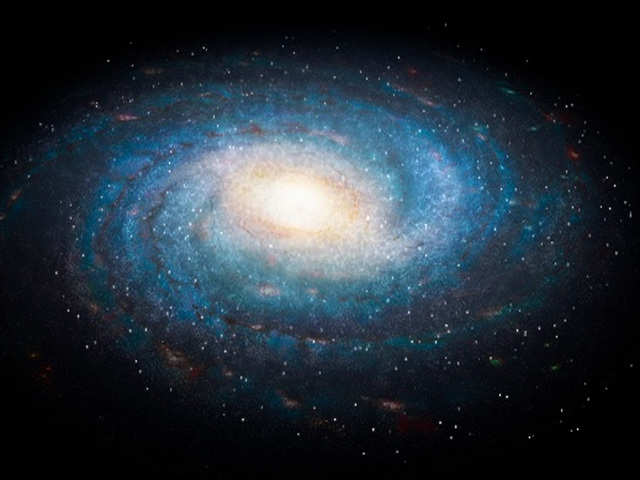 |
| ESO |
The Milky Way Galaxy is a huge disc of gas, dust, stars and planets that spreads around 150,000 light-years across and several thousand light-years thick. The Milky Way contains our Solar System and is the home for our home planet - Earth.
The Milky Way is a barred spiral galaxy. It contains around 100-400 billion stars and more than 100 billion planets.
Up until late 1920s Milky Way galaxy was thought to be as big as the universe and all the stars and nebulae we see are in the galaxy itself. It was during this time when Edwin Hubble determine a special type of star called as Cepheid Variable and calculated the distance of the Andromeda Galaxy which was thought to be a nebula in the Milky Way galaxy. Following his calculation Hubble concluded that the Andromeda was too far to be in the Milky Way and that it was a different galaxy.
Age and Formation :
The formation of the Milky Way galaxy is still a matter of debate. Shortly after the Big Bang, Milky Way started as one of the several overdensities in the mass distribution of the universe. These overdensities resulted in the formation of the globular clusters in which the oldest remaining stars of the Milky Way were formed.
Almost half of the matter in the Milky Way have come from other distant galaxies. Since the formation of the first stars, the Milky Way galaxy has grown through galactic merger. However, its properties such as the stellar mass, angular momentum and metallicity in the outermost regions suggest that it has not undergone any merger with a large galaxy in the past 10 billion years which is unusual for a galaxy like the Milky Way.
The globular clusters are the oldest remains of the Milky Way and helps in determining the age of the galaxy. Milky Way is estimated to be around 12.6 billion years old. However, in November 2018 astronomers discovered one of the oldest stars in the universe which was around 13.5 billion years old. This meant that the Milky Way may be much more older than we previously thought.
Location of Milky Way in the Universe :
The Milky Way galaxy belongs to a group of 50 closely bound galaxies known as the Local Group. The Milky Way is the second largest galaxy of the Local Group while Andromeda is the largest.
.png/1024px-06-Local_Group_(LofE06240).png) |
| Add caption |
The Local Group is surround by the Local Void which itself is a part of Virgo Supercluster. The Virgo Supercluster itself is a part of the even greater structure called Liniakea. Liniakea is a cluster of 100,000 nearby galaxies with Milky Way being one of them.
Our Place in the Milky Way :
The center of the Milky Way contains a super massive black hole named Sagittarius A which is more than 4 million times the mass of the sun.
The solar system is located in the Orion Arm of the Milky Way and orbits the galactic center at a distance of about 27,000 light-years. The Sun orbits the galactic center at approximately 220 km/s and take 240 million years to complete one revolution! Since its birth, Sun has completed 20 revolution around the galactic center.
Collision with Andromeda Galaxy :
The Andromeda Galaxy is approaching the Milky Way at a speed of whooping 110 km/s ..... not so whooping though! Both galaxies are predicted to collide in 4.5 billion years. It is also expected that the Triangulum Galaxy is also going to participate in the collision as well. And the cool thing is, we have a name for the final product - "MIKLDROMEDA" .
The collision is predicted to last 2 billion years! The Mikldromeda is likely to be a elliptical galaxy.
I know there are a lot of "doomsday thoughts" in our minds right now .... but, wait....
The stars are a lot far from each other. Look at the closest star we have, it is 4.2 light-years from us! The chances of head-on collision between star are very low. Some stars might collide while some might get stranded in the universe.
Based on the current calculations there are 50% chances that the Solar System will drift at a distance thrice than that it is in present. Well, there are 12% chances that Sun will shoot out of the galaxy....quite high. But by then Sun will become a swollen red ball and Earth will be hell of a planet to live. Hope that we find some new place to move to........

.png/1024px-07-Laniakea_(LofE07240).png)





0 Comments